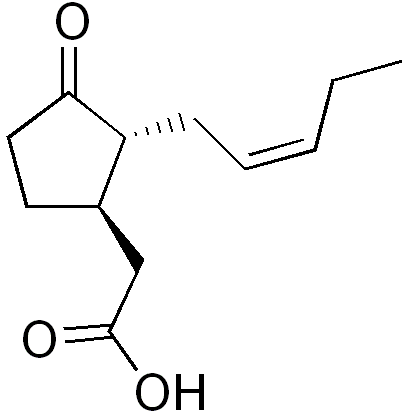Octadecanoid Pathway on:
[Wikipedia]
[Google]
[Amazon]

 The octadecanoid pathway is a
The octadecanoid pathway is a Jasmonic Acid Synthesis
/ref>

biosynthetic
Biosynthesis is a multi-step, enzyme-Catalysis, catalyzed process where substrate (chemistry), substrates are converted into more complex Product (chemistry), products in living organisms. In biosynthesis, simple Chemical compound, compounds are mo ...
pathway for the production of the phytohormone
Plant hormone (or phytohormones) are signal molecules, produced within plants, that occur in extremely low concentrations. Plant hormones control all aspects of plant growth and development, from embryogenesis, the regulation of organ size, pat ...
jasmonic acid (JA), an important hormone for induction of defense genes. JA is synthesized from alpha-linolenic acid
''alpha''-Linolenic acid (ALA), also known as α-Linolenic acid (from Greek ''alpha'' meaning "first" and ''linon'' meaning flax), is an ''n''−3, or omega-3, essential fatty acid. ALA is found in many seeds and oils, including flaxseed, waln ...
, which can be released from the plasma membrane
The cell membrane (also known as the plasma membrane (PM) or cytoplasmic membrane, and historically referred to as the plasmalemma) is a biological membrane that separates and protects the interior of all cells from the outside environment (t ...
by certain lipase
Lipase ( ) is a family of enzymes that catalyzes the hydrolysis of fats. Some lipases display broad substrate scope including esters of cholesterol, phospholipids, and of lipid-soluble vitamins and sphingomyelinases; however, these are usually tr ...
enzymes. For example, in the wound defense response, phospholipase C
Phospholipase C (PLC) is a class of membrane-associated enzymes that cleave phospholipids just before the phosphate group (see figure). It is most commonly taken to be synonymous with the human forms of this enzyme, which play an important role ...
will cause the release of alpha-linolenic acid for JA synthesis.
In the first step, alpha-linolenic acid is oxidized
Redox (reduction–oxidation, , ) is a type of chemical reaction in which the oxidation states of substrate change. Oxidation is the loss of electrons or an increase in the oxidation state, while reduction is the gain of electrons or a d ...
by the enzyme lipoxygenase
Lipoxygenases () are a family of (non-heme) iron-containing enzymes most of which catalyze the dioxygenation of polyunsaturated fatty acids in lipids containing a cis,cis-1,4- pentadiene into cell signaling agents that serve diverse roles as auto ...
. This forms 13-hydroperoxylinolenic acid, which is then modified by a dehydrase and undergoes cyclization by allene oxide cyclase to form 12-oxo-phytodienoic acid. This undergoes reduction and three rounds of beta oxidation to form jasmonic acid./ref>
Footnotes
References
* * Metabolic pathways {{biochem-stub